Warcraft III Beta Report: The Human Alliance
The human alliance returns stronger than ever in Warcraft III. Find out how the humans conduct battle in these in-depth gameplay details, straight from the beta.
| Human Heroes: | ||||
| | ||||
| ||||
If you asked Warcraft II veterans whether the orcs or the humans were the strongest in that game, they'd probably just look at you funny. After all, the orcs' ogre-mages, with their extremely powerful bloodlust spell, were practically unstoppable in large groups--the healing spells of the human paladins could do little to alleviate the massive damage caused by the ogre-mages' gigantic fists. Though cunning human players would employ mages to good effect--invisible mages could sneak into enemy bases, then polymorph a foe of their choice into a harmless sheep--most Warcraft II players agree that the orcs were easier to play. Now, in Warcraft III, it's payback time. The humans are back and tougher than ever.
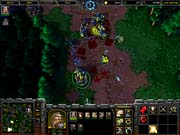
"Humans" is a misnomer. As you may know, when Warcraft III refers to humans, the term is used broadly to encompass what's actually an alliance of humanoid races, including elves and dwarves as well as humans. Each of these races forms a critical part of the human faction in Warcraft III. Generally speaking, the humans themselves form the main fighting force of the human alliance, the elves are the humans' primary spellcasters, and the dwarves assist their allies with their technology.
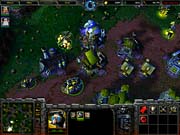
Every faction in Warcraft III has particular advantages over the others, and the humans' main advantage lies squarely in the technological edge they have. Their technology gives the humans a defensive disposition--their Warcraft II-era guard towers and cannon towers are still available, and their buildings are strong and well built, but the humans also have a number of brand-new inventions. Human units may not be overpowering on a one-to-one basis compared with the roughly equivalent units in the other factions. But the humans have a number of powerful upgrades that can be researched, as well as a number of highly useful magic spells that can tip the scales in their favor.
Does the new dwarven rifleman make a suitable replacement for the old elven archer? And is there a suitable replacement for Warcraft II's ballista? How good are the gyrocopter's weapons, anyway? Find out about the human alliance's military capabilities next.
The Human Forces
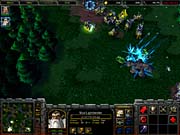
Playing as the humans in Warcraft III will feel very familiar to Warcraft II players. You must gather resources just as you always have--by recruiting peasants from a town hall and ordering them to mine gold or chop down trees. Peasants can also construct buildings or be used to repair damaged buildings. The humans' primary fighting units are trained at the barracks. Initially, only footmen are available. These well-armored and inexpensive fighters are equipped with swords and shields. Footmen can learn the defend ability, which makes them move cautiously and with their shields up. Footmen can remain in defend mode indefinitely, and while defending, they will suffer only one point's worth of damage from all ranged attacks--but they will also move at a slower rate and deal out less damage per hit. Still, this defensive posture makes footmen very valuable in many situations, especially against the night elves, who rely heavily on their archers.
| Human Heroes: | ||||
| | ||||
| ||||
The human knight is the final unit available at the barracks, though it cannot be trained until you've upgraded your town hall all the way up to a castle. Knights are powerful, swift melee fighters. The husbandry skill, available at the gryphon aviary structure, boosts these units' hit points significantly, as well as the hit points of the dwarven gryphon riders--the mighty hammer-throwing warriors from Warcraft II, who are as powerful as ever in the new game and are still capable of flying to just about any point on the map.
The steam tank isn't the only technology available to the humans. They can construct gyrocopters, which are as excellent as ever for scouting, only they now come equipped with standard-issue machine guns that are extremely effective against flying targets. Additionally, as if the steam tank weren't sufficient for destroying enemy fortifications, the humans can also recruit dwarven mortar teams, which armed with long-range cannons that can seriously damage units and structures alike.
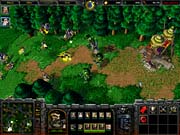
You can't win a war with technology alone. As such, the human alliance employs elven priests and sorceresses in supporting roles. You may recognize many of their spells from Warcraft II, and others from Blizzard's hack-and-slash RPG Diablo II. Priests begin with the inner fire ability, which temporarily boosts the target unit's attack and defense ratings. They can later learn the dispel-magic ability, which negates negative effects from friendly units or beneficial effects from enemy units. Finally, priests can learn a healing spell, which restores lost hit points. Any one of these spells can be set to auto-cast.
Sorceresses are similar to Warcraft II's mages. They begin with the slow spell, which reduces enemy movement and attack speed significantly. They later gain invisibility, which renders the target unit invisible to enemy eyes until it attacks. Sorceresses cannot cast invisibility upon themselves, however. Finally, sorceresses can learn polymorph, which turns ground units into harmless animals for a while and kills flying units outright.
How does all this military might fit together in practice? Find out next.
Defending Your Honor
| Human Heroes: | ||||
| | ||||
| ||||
Resource gathering and base building are as simple as can be while playing as the humans. Yet a great deal of tactical depth can be found in how you use all the units available to you. Though they aren't available right away, knights are better all-around fighters than footmen--but your footmen and their defend ability can play an invaluable role at any point in a battle. Your dwarven riflemen are helpful in any situation, too, although you should seriously consider using gyrocopters to aid in defense against flying opponents. These, along with guard towers (and, later in a battle, sorceresses with the polymorph spell), should be able to protect you against any aerial invaders.
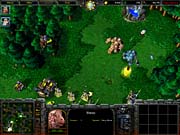
Though their technology is their most obvious strength, the humans have very powerful magic. Once your priests have learned the healing ability, they become an essential component of every group. Furthermore, if you've ever played Warcraft II, then you know the power of the Warcraft III sorceress' invisibility and polymorph spells. These, along with your heroes' abilities, can be used to overwhelm enemy forces whose units otherwise seem more powerful than yours. As the humans, you'll almost certainly wish to use magic as a core part of your strategy.
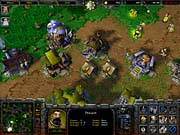
Of further note are the humans' steam tanks and mortar teams, which help demolish enemy structures. The other factions have only one unit each that's especially suited to siege combat. Bear in mind, though, that both your tanks and your mortars are actually very vulnerable. You'd be wise to protect them with ranks of footmen, as well as magic users. Also, for late in the battle, keep your powerful gryphon riders in mind--while expensive, they are beneficial to virtually any battle group.
The humans have a number of unique technologies, including various upgrades to their buildings' hit points and armor, a magical upgrade that lets guard towers detect invisible units, and improvements to lumber harvesting that make peasants more effective at chopping wood. These technologies, along with the human peasants' ability to construct guard towers or cannon towers just about anywhere on the map, mean that humans are effective both at defending themselves and at walling in enemy forces. Their technology makes the humans competitive--and their magic makes them downright devastating when commanded effectively. The humans may not seem as imposing as the orcs or the undead, but you can fully expect them to be a real contender once Warcraft III is finally finished.
Got a news tip or want to contact us directly? Email news@gamespot.com
Join the conversation